by Joe Gourd
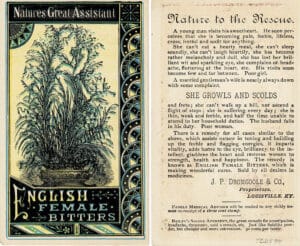
We live today in a sea of color images, printed and electronic, and we find it hard to imagine a time when media in color was considered a prized possession. Back in the late 19th century, most advertising was done in black-and-white newspaper ads, but with the invention of chromolithography (color lithography), it became practical to print ads in color for the first time.
Colorized Trade Cards Instant Success
Trade cards are some of the earliest examples of chromolithography in America and were used as advertisements. Some of the notable lithographic firms of the time were Currier and Ives and Louis Prang, the inventor of the Christmas card.
A trade card, sometimes referred to as an “Advertising Trade Card” or a “Victorian Trade Card,” is typically about the size and shape of a baseball card with a pretty picture on the front side and an advertising message on the reverse side (see fig. 1). Often, the merchant who gave out the cards was stamped on the reverse side. In this instance, the word “trade” refers to a tradesman rather than swapping or exchanging back and forth. Think of them like a 19th century version of today’s business card.
Types of Trade Cards
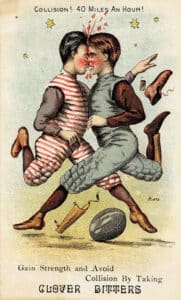
Joe Gourd Collection.
The cards come in basically two forms. The first is called a “stock card” as in “in stock” or inventory (see fig. 2). They were cheap and could be quickly printed. They often were printed with some type of non-specific universal image like a playful child, a seasonal scene, a pretty young woman, or a pet animal. They could be used by any advertiser for any product or service. The advertised product name, company name, and address could be over-printed on the image. The advertising message would appear on the back of the card. Typically, they were printed in like-themed sets of 2, 4, 6, 10, or more cards. One set that I know of has a total of 48 cards in it.
The second type of trade card is called a “private design” card (see fig. 3). These were considerably more expensive to produce. Typically, the product or service, in some form of use, would be displayed on the front of the card. Sometimes, the card would even show the benefit of using the product before and after taking it. The back held the advertisement or could be left blank. Private design trade cards are the most desirable to collectors.
There is a third possible type of trade card called a “die-cut.” They can either be a stock card or a private design card. They are unlike a typical trade card in shape and are produced by using a cookie cutter-like device called a “die.” The printer would use larger sheets of paper that were then trimmed to size using the die.
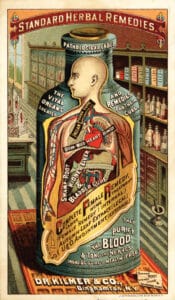

The Trendy Side of Advertising Trade Cards
Trade card collecting was a popular fad from the late 1870s through the 1890s. They advertised every imaginable product and service of the time. Some of the products most heavily advertised included patent medicines (see fig. 4), food, tobacco, clothing, personal grooming (see fig. 5), household items and furniture (see fig. 6), and machinery (see fig. 7). In short, they covered every aspect of life in the late 19th century, designed with the idea that they would be held onto by the buyer as a constant reminder of the product or service advertised. These colorful cards were printed by the hundreds of thousands and given away free by merchants. They were mainly collected and pasted into scrapbooks for fun and made an interesting family pastime. Those same scrapbooks, taken apart by soaking the pages, are the highly prized source of most of the trade cards that exist in today’s marketplace.
With Change Comes More Cards
The Victorian Era in the United States was a period of high activity and great change. Highlighted by the addition of new states to the Union, the discovery of gold in California, the Arts and Crafts Movement, the Temperance Movement, the emergence of sports as a national pastime, the 1893 Columbian Exposition, and much, much more.
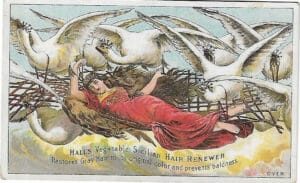
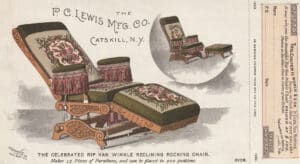
A good example of the expanding statehood during this time is shown in figure 8, “Williams Genuine Yankee Soap.” Here, we see a 36-star American Flag that was official from July 4, 1865, to July 4, 1867, following the admission of Nevada into the Union on October 31st, 1864.
The California Gold Rush (1848-1855) began when gold was discovered at Sutters Mill. The news of gold brought approximately 300,000 people to California from the rest of the U.S. and abroad. They arrived using all forms of transportation, including ships like the one seen in figure 9 – the preferred method used by Easterners heading West.
The Arts and Crafts Movement was initiated in reaction to the perceived impoverishment of the decorative arts and the conditions in which they were produced. The movement flourished in Europe and North America between about 1880 and 1920. Proponent William Morris’ flora and fauna patterns would ultimately influence many graphic designs of the period (see fig. 1).
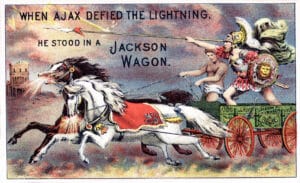
The Temperance Movement was a significant mass movement during from 1860 to 1920, encouraging general abstinence from alcohol (see fig. 10). It was spearheaded by the Women’s Christian Temperance Union, an international temperance organization formed in 1873. It was dedicated to many far-reaching reform programs including Women’s Suffrage and Women’s Right to Vote. One of its more colorful members was Carrie (Hatchet Mary) Nation. She made her reputation by smashing up saloons all around Kansas.
America’s passion for team sports began during the 19th century. The first recorded game of baseball in the United States was played in New York in 1845 between the New York Baseball Club and the Knickerbocker Baseball Club. Its inventor is popularly attributed to Abner Doubleday. American Football was first played in 1869 between two college teams, Rutgers and Princeton (see fig. 2), under rules drawn up by Walter Camp. Basketball began with its invention in 1891 in Springfield, Massachusetts by Canadian James Naismith as a less injury-prone sport than football.
The Pinnacle of Collecting
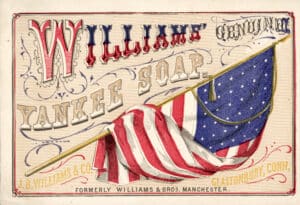
The high-water mark for collecting trade cards occurred during the 1893 Columbian World Exposition. Hundreds of thousands of cards were handed out to visitors by the exhibitors as souvenirs and, of course, advertising.
The World’s Columbian Exposition held in Chicago, Illinois, commemorated the 400th anniversary of Christopher Columbus’s arrival in the New World took place from May 5, 1892, to October 31, 1893. Forty-six countries exhibited and there were over 23 million visitors. Main attractions included the very first Ferris Wheel – it stood 80 feet high and had 36 cars, each of which could hold 40 people. Buffalo Bill Cody held a “Wild West Show” featuring Annie Oakley. Nikola Tesla demonstrated alternate current electricity in the “City of Light” showing the world the magic of electrically powered streetlights illuminating the Fair at night. An Edison phonograph concealed in a 10-foot automaton dressed as “Uncle Sam” was used to deliver 40,000 speeches during the Exposition (see fig. 11).
With More Change, Less Cards
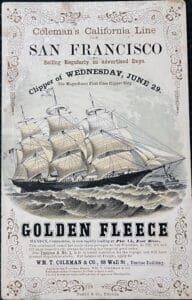
John Kemler Collection.
Soon after, trade card advertising declined rapidly. This was due to several factors. First was the emergence of magazine color advertising that reached larger and larger audiences at more competitive rates.
Next was the “1906 Pure Food and Drug Act.” It required patent medicine makers to disclose drugs like cocaine and morphine and the percentage of alcohol contained in their products. Finally came the popularity of collecting postcards. Trade cards were deemed passé. Postcards could be collected and placed in specially designed albums which, for many, replaced scrapbooks.
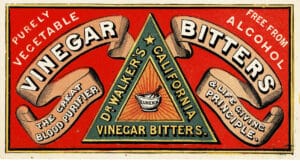
Collecting Today
Something about collecting trade cards that is different is that my entire collection fits on four shelves in a closet and I never have to wash or dust them. Also, there is no complete catalog or guide for trade cards like there is for stamps or coins. You really don’t know what you are looking for – it shows itself to you and strikes a chord with the collector in you. Collectors are continuously surprised by the next card they buy as likely they have never seen it before. Or, in the case of stock cards, you may have seen the trade card image often used for other products but never for the product you collect. It is up to the individual collectors to create checklists of known cards for their special interest. These then are shared with other collectors to act as a guide in what to look for.
The best place, by far, to find any type of advertising trade card is online. In most cases, these cards range in price from $5 to $25. There are a few that are valued at $1,000 or more, but nowhere else can you have access to such variety from the U.S. and beyond as you can online. Other good sources for trade cards are Advertising Shows, Post Card Shows, Bottle Shows, Antique Shows, and Auctions. I also suggest that you join a collectors’ organization and get to know the other members. Many will have duplicates from their collections to trade or sell. I highly recommend The Ephemera Society of America and The Federation of Historical Bottle Collectors (FOHBC).
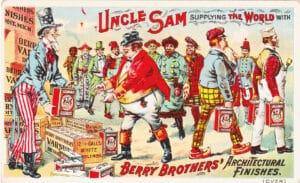
About the Author:
In 1970, Joe Gourd, along with several other collectors, formed the Metropolitan Detroit Antique Bottle Club where he served as its first president. Several years later, he moved to California and joined the San Jose Bottle Collectors Association, then two years after that he moved to Chicago, Illinois, where in 1976 he became a member of the 1st Chicago Bottle Club. Joe’s collection of Bitters trade cards numbers around 3,300 items … and is still growing. It contains some form of advertising for over 1,200 different Bitters. Joe has lectured on all aspects of antique bottle collecting, published magazine articles on bitters trade cards, and more recently collaborated with authors Bill Ham and Ferdinand Meyer in the writing of the Bitters Bottles Supplement 2 reference book. Additionally, he is a longtime member of the Ephemera Society of America. Joe still resides in the Chicago area with his lovely wife, Edith.

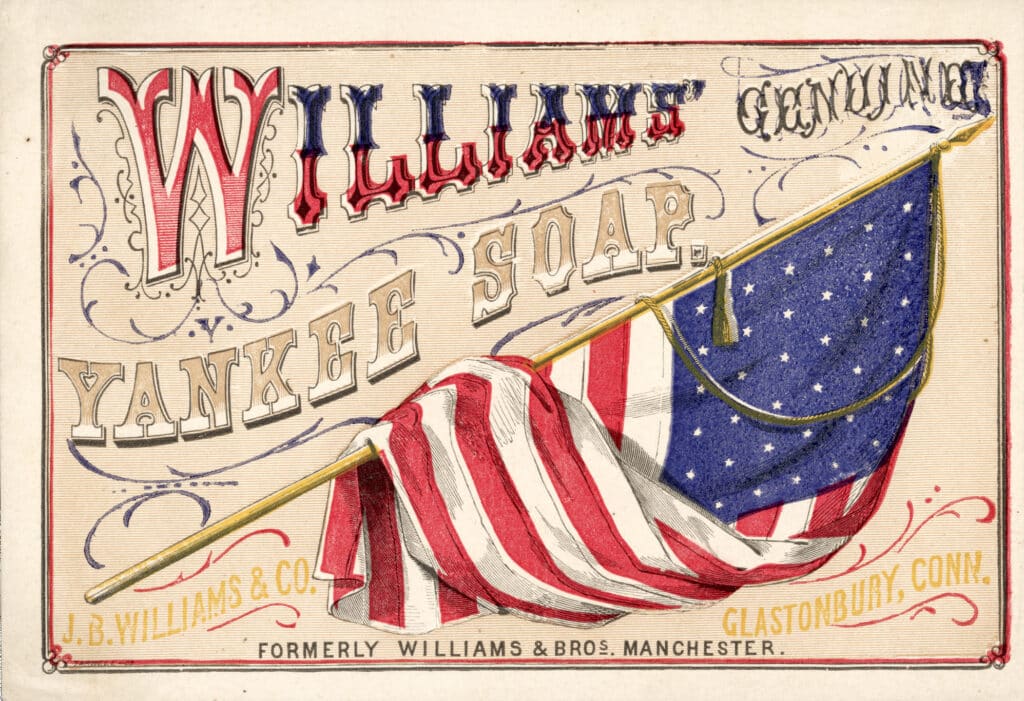




Related posts: